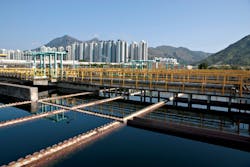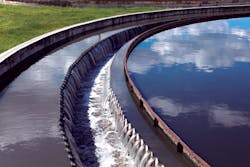With funding for wastewater treatment infrastructure in the US increasingly stretched, the idea of recovering valuable nutrients and even precious metals such as silver is gaining momentum. In addition to the recent EPA blueprint aimed at encouraging the integration of such technologies, scientific organisations such as the Water Environment Research Foundation are working to bring such technologies to commercial fruition.
by Carrie W. Capuco
In its most recent infrastructure report card, the American Society of Civil Engineers (ASCE) gave the state of US water infrastructure, encompassing dams, levees, wastewater and drinking water infrastructure, an average grade of a D.
According to the report, as of 2008 the US has approximately 14,780 wastewater treatment facilities and 19,739 wastewater pipe systems.
Although access to centralised treatment systems is widespread, the condition of many of these systems is reported to be poor, with aging pipes and inadequate capacity leading to the discharge of an estimated 900 billion gallons (3.4 billion cubic metres) of untreated sewage each year.
The US Environmental Protection Agency (EPA) estimates that the cost of the capital investment required to maintain and upgrade drinking-water and wastewater treatment systems across the US in 2010 was $91 billion. However, only $36 billion of that was funded, leaving a capital funding gap of nearly $55 billion.
Blueprint for innovation
In March this year the EPA published its Blueprint for Integrating Technology Innovation into the National Water Program.
The Blueprint highlights the EPA Office of Water's plans to advance and promote technology innovation across various water programs.
"Technology innovation can accelerate progress toward our goals of clean and safe water. EPA and many stakeholders will strive to support technology innovation to solve water resource problems…cheaper, faster and using less energy," explains Nancy Stoner, acting assistant administrator for water at the EPA.
To this end, the blueprint notes that the 150,000 drinking water and 15,000 wastewater facilities nationwide account for as much as 4% of the country's electricity consumption - approximately 56 million MWh at a cost of around $4 billion. As such, energy conservation and recovery are said to hold significant promise for reducing energy consumption and treatment costs, while certain technologies may even turn some of these facilities into net energy producers.
Wasted not wastewater
According to the EPA's blueprint, wastewater facilities in the US process approximately 9.5 trillion gallons (36 billion cubic metres) of wastewater per year. However, the agency says that due to a combination of drought and increasing water demands, wastewater should be viewed through a new paradigm - as 'water that is wasted'.
With this in mind, the blueprint explains that there are significant needs for technologies and approaches that foster substantially greater water reuse, which in turn can reduce pollution and conserve energy. Further to the potential to reduce the energy consumption of certain wastewater treatment processes, as well the as ability to recover energy from others, the blueprint also notes the impact being felt from nitrogen and phosphorus pollution, which is threatening surface water quality and drinking water supplies. New techniques are needed to reduce nutrient pollution at substantially less cost and with reduced carbon footprint.
To this end the agency also highlights a number of emerging technologies which can recover nutrients, such as phosphorus and nitrogen, from water/wastewater for use/reuse elsewhere.
Resource recovery
With wastewater being increasingly recognised as a valued source of renewable resources, the EPA is urging wastewater treatment facilities, which treat human and animal waste, to be viewed as Renewable Resource Recovery Facilities that produce clean water, recover energy and generate nutrients.
This view is backed by not-for-profit organisation, the Water Environment Federation (WEF), which believes that wastewater treatment plants are not waste disposal facilities, but rather water resource recovery facilities that produce clean water, recover nutrients. Such facilities, it argues in a position statement, have the potential to reduce the nation's dependence on fossil fuels through the production and use of renewable energy.
The potential to transform these facilities exists because wastewater contains potentially marketable products. However, technical, social, and economic challenges remain before treatment plants can realise the full potential of nutrient recovery from wastewater.
Numerous individual products can be recovered from wastewater treatment plants, including biodegradable plastics, adhesives, and enzymes useful in biomedical applications. Additionally, several carbon based materials such as biopolymers, PHAs and others, are present in domestic wastewater and perhaps biosolids.
There are however, lingering questions about the quality, product yield and technological requirements, as well as the practicality of recovering these products at a municipal facility.
Markets value and demand for these products are also not well understood. In addition, there is a need to better understand the relevant trade-offs and consequences, including those that may directly affect discharge permit compliance.
Research needed
Many scientific papers have been published on the availability of these products in wastewater. However, the industry needs to get an objective and unbiased view of the value and current and future demand for these products.
This will help the industry to position for the both the medium and long term in its attempts to become energy neutral and environmentally and economically sustainable. One of the critical knowledge gaps is a comprehensive technical and economic review of existing and emerging technologies which can produce carbon-based and/or non-nutrient products from wastewater or wastewater by-products.
The Water Environment Research Foundation (WERF) hopes to support projects that can fill these vital knowledge gaps while also providing practical information for water utilities interested in expanding their investment in resource recovery.
WERF is seeking answers to resolve several resource recovery questions with its current funding research on the recovery of three resources: macro-Nutrients, Energy and Water. The organisation has also funded research on appropriately treated sewage sludge (biosolids), as a resource in the form of a nutrient rich soil amendment.
The overarching goal of the Resource Recovery program is to transition the wastewater treatment industry to one focused on resource recovery (starting with nutrients) with the vision that most, if not all, materials in wastewater can be commoditised.
In the area of energy, WERF is seeking to advance processes/practices with potential for energy recovery/efficiency or which address barriers to energy recovery in the wastewater treatment process. The overarching goal of WERF's Energy program is to develop information that will support net energy neutrality at all wastewater facilities starting with those that treat flows of five million or more gallons per day (18,900 m3/day).
Transition
To initiate a transition toward nutrient recovery, in 2012, WERF selected a global research team to begin to understand and guide the acceptance and implementation of nutrient recovery from wastewater. This research (WERF project # NTRY1R12) also focuses on extractive macro-nutrient recovery technologies for phosphorus.
In the last few years, the potential to recover phosphorus has increased dramatically. This represents an emerging frontier for utilities to address both nutrient load limitations and to develop alternative revenue streams.
The international team, led by Hazen and Sawyer, has collaborated with other consulting firms, utilities, technology providers, and academic experts to achieve three main objectives:
• Characterise factors influencing the adoption of resource recovery systems (primarily on macro-nutrients, nitrogen and phosphorus)
• Provide a guidance tool for the implementation of resource recovery technologies for water resource recovery facilities (previously known as WWTPs)
• Experimentally evaluate phosphorus recovery technologies.
Then, WERF's newest research will build upon the prior and on-going research by focusing on additional resources: value-added commodities or groups of commodities that are likely to be used by utilities (e.g., methanol or other specialty chemicals or precursors, carbon-based compounds, etc.).
It will also focus on commodities that can be produced in quantities that can be effectively marketed and/or used regionally - such as hydrogen peroxide, high-quality 'designer' biosolids products with specific N-P-K ratios, or other products that can be sold, etc.
Additional commodities that could be recovered may also be studied if they are determined to be economically viable, such as metals including silver, micro-nutrients, biodegradable plastics/polymers, etc., while having no detrimental impact in the overall final effluent quality.
This effort seeks pioneering research that will advance knowledge and understanding on the generation or recovery of a particular commodity, or group of commodities, that can be recovered from wastewater. It will complement WERF's ongoing initiatives in evaluating and demonstrating new technologies to accelerate the adoption of innovative treatment technologies
Rationale
This research is needed because as various new technologies and processes that could be used to recover potentially valuable commodities intrinsically present in wastewater are currently being researched and developed. Water Resource Recovery Facilities (WRRFs) that would benefit from these new technologies need a scientifically sound view of the new technologies that can be adopted as part of their standard processes.
It is hoped WERF's research results will help the Water quality community position itself for both the medium and longer term in its strategic attempts to transform WRRFs to be energy neutral, environmentally, and economically sustainable.
Ultimately, in order to promote WRRFs as product recovery facilities, the water quality community must demonstrate that these facilities can generate or produce high quality value-added products. These must be able to be used to either enhance facility operations and economics or more generally meet the needs of our communities and economies. WERF's newest portfolio of research seeks to accomplish that task.
Conclusions
Water and wastewater treatment infrastructure is facing a significant, and growing, funding gap in the US. The prospect of reducing the cost of treatment, or increasing the revenue generated through the production of additional marketable energy, nutrients and commodities is an appealing one.
The idea of recovering valuable products from wastewater may once have seemed fanciful, but encouraged by the noises coming from federal government, it's a prize that many in the water quality community are working towards.
Of the wide variety of innovative projects underway not all will succeed, but those that do may just hold the key to plugging the funding gap for US wastewater treatment infrastructure.
Carrie W. Capucois director of communications at WERF. For more information on resource recovery, email: [email protected].




